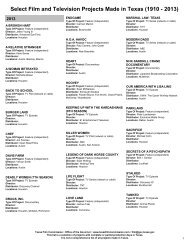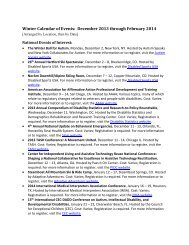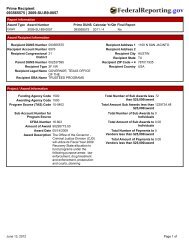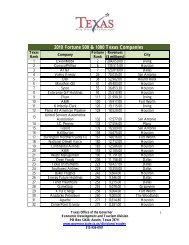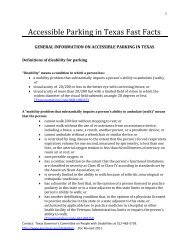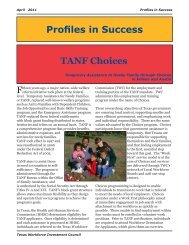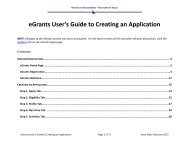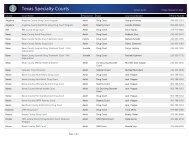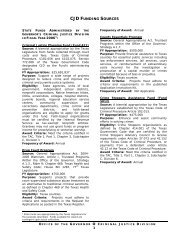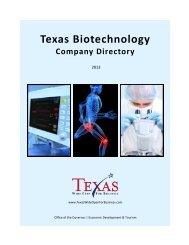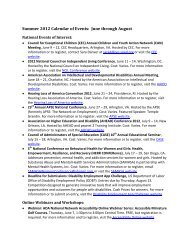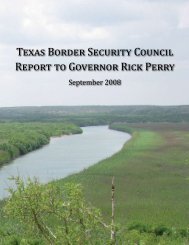People with Disabilities: A Texas Profile
People with Disabilities: A Texas Profile
People with Disabilities: A Texas Profile
You also want an ePaper? Increase the reach of your titles
YUMPU automatically turns print PDFs into web optimized ePapers that Google loves.
Table 12: <strong>Texas</strong> Labor Force Participants <strong>with</strong> and <strong>with</strong>out <strong>Disabilities</strong> by Age Category, 2011<br />
Age Categories<br />
Total Number Of<br />
Labor Force<br />
Participants in<br />
Each Age<br />
Category<br />
Labor Force Participants<br />
<strong>with</strong> a Disability<br />
Labor Force Participants<br />
<strong>with</strong>out a Disability<br />
Number Percent Number Percent<br />
16 to 24 years 1,848,014 76,549 4.1% 1,771,465 95.9%<br />
25 to 64 years 10,196,763 624,888 6.1% 9,571,875 93.9%<br />
65 to 74 years 399,416 70,283 17.6% 329,133 82.4%<br />
75 years and over 70,255 25,606 36.4% 44,649 63.6%<br />
Total 12,514,448 797,326 6.4% 11,717,122 93.6%<br />
Table notes: 2011 ACS microdata.<br />
Table 13 represents the types of disabilities reported by individuals according to labor force<br />
participation status. Approximately 60 percent of individuals <strong>with</strong> disabilities who worked full time<br />
reported ambulatory difficulties and 36 percent reported hearing difficulties. The most frequently<br />
reported difficulties for part time workers were ambulatory (39.5 percent), cognitive (34.4 percent), and<br />
hearing (26.5 percent). Individuals who were not in the labor force reported ambulatory (64.7 percent),<br />
independent living (46.9 percent), and cognitive (37.6 percent) difficulties.<br />
Table 13: Types of <strong>Disabilities</strong> Reported by Individuals Age 16 and over by Labor Force Participation,<br />
2011<br />
Full‐Time Workers Part‐Time Workers Not in Labor Force<br />
Disability<br />
Number Percent Number Percent Number Percent<br />
Ambulatory difficulty 296,879 60.3% 70,053 39.5% 1,217,937 64.7%<br />
Independent living difficulty 62,983 12.8% 32,134 18.1% 883,181 46.9%<br />
Cognitive difficulty 101,320 20.6% 60,950 34.4% 706,941 37.6%<br />
Hearing difficulty 178,264 36.2% 47,039 26.5% 552,049 29.3%<br />
Self‐care difficulty 43,986 8.9% 16,195 9.1% 510,090 27.1%<br />
Vision difficulty 113,164 23.0% 36,425 20.5% 388,100 20.6%<br />
Table notes: 2011 ACS microdata. The same individual may report multiple disabilities.<br />
Labor force participants <strong>with</strong> disabilities held various jobs in numerous industries throughout <strong>Texas</strong> in<br />
2011. Table 14 on page 24 illustrates the percentages of labor force participants <strong>with</strong> and <strong>with</strong>out<br />
disabilities by general category of work, also referred to as “class of worker.” Approximately six percent<br />
of the employees of private, for‐profit companies had disabilities in 2011. Approximately seven percent<br />
of federal, state, or local government employees had a disability. The total number of <strong>Texas</strong> labor force<br />
participants <strong>with</strong> disabilities was 797,326 (employed full‐, part‐time and unemployed) in 2011. The total<br />
number of <strong>Texas</strong> labor force participants <strong>with</strong>out disabilities was 11,717,122.<br />
<strong>Texas</strong> Workforce Investment Council 23



